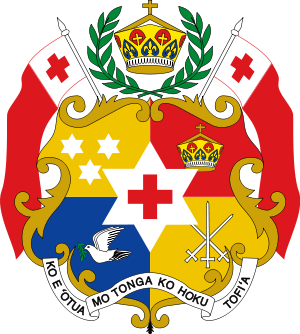- Coat of arms of Tonga
-
Coat of arms of Tonga 
Details Armiger Siaosi Tupou I Adopted 1875 Crest royal crown of Tonga with the olive branch Escutcheon The first quadrant, or contain three mullets argent;
the second quadrant, gules the royal crown of Tonga;
the third quadrant, azure contains a dove volant holding an olive branch;
fourth quadrant, or contains three swords in saltire handled gules;
overall a mullet argent ensigned with a cross couped gules.Motto Tongan: "Ko e ʻOtua mo Tonga ko hoku Tofiʻa" ("God and Tonga are my inheritance") Use Royal government of Tonga The coat of arms of Tonga (ko e Sila ʻo Tonga) was designed in 1875 with the creation of the constitution. The three swords represent the three dynasties or lines of the kings of Tonga, namely the Tuʻi Tonga, Tuʻi Haʻatakalaua and the current Tuʻi Kanokupolu). Tonga was finally united under one king, King Siaosi Tupou I, who then orchestrated the formation of the first formal government and also the coat of arms. The dove with the olive branch symbolises the wish of God's peace to reign in Tonga forever (the dove and olive branch are taken directly from the story of Noah and the Great Flood in the Holy Bible). The three stars symbolise the main island groups of Tonga, which are Tongatapu, Vavaʻu and Haʻapai. The Crown symbolises the ruling monarchy, the King of Tonga. The text on the scroll at the bottom reads Ko e ʻOtua mo Tonga ko hoku Tofiʻa in the Tongan language: God and Tonga are my inheritance.
There is no official specification of how exactly the arms should look. Even the shield on the front gate of the late king's palace is different from the old black/white copy used by the (ex-) government printer on all official stationery, is different from the copy on the prime minister's office webpage, etc. Some have pointed crowns, some rounded; some have normal flags, others have flags looking more like banners; some use the modern orthography, some the old (Ko e Otua mo Toga ko hoku Tofia); some have black swords, others white; and so forth.
Contents
The Royal Standard
The Royal Standard of Tonga, the personal monarch's flag, consists of the Royal Arms of Tonga in banner form. It is split into the four quadrants of the coat of arms:
- The first quadrant, or contain three mullets argent;
- the second quadrant, gules the royal crown of Tonga;
- the third quadrant, azure contains a dove volant holding an olive branch;
- fourth quadrant, or contains three swords in saltire handled gules;
- overall a mullet argent ensigned with a cross couped gules.[1]
See also
Notes
- ^ Standard of Tonga (Flags of the World)
External links
Seals and coats of arms of Oceania Sovereign states Dependencies and
other territories- American Samoa
- Christmas Island
- Cocos (Keeling) Islands
- Cook Islands
- Easter Island
- French Polynesia
- Guam
- Hawaii
- New Caledonia
- Niue
- Norfolk Island
- Northern Mariana Islands
- Pitcairn Islands
- Tokelau
- Wallis and Futuna
Categories:- National symbols of Tonga
- National coats of arms
- Tongan coats of arms
Wikimedia Foundation. 2010.

